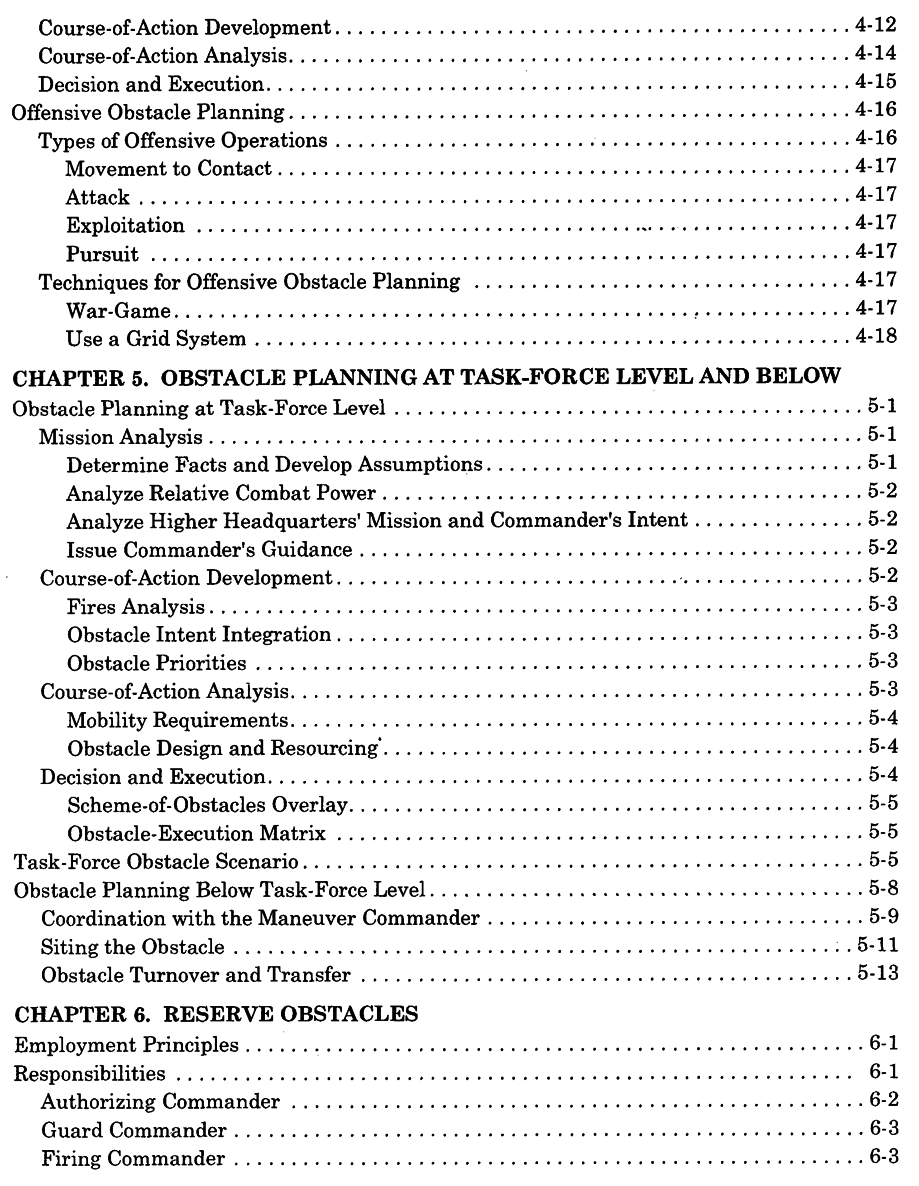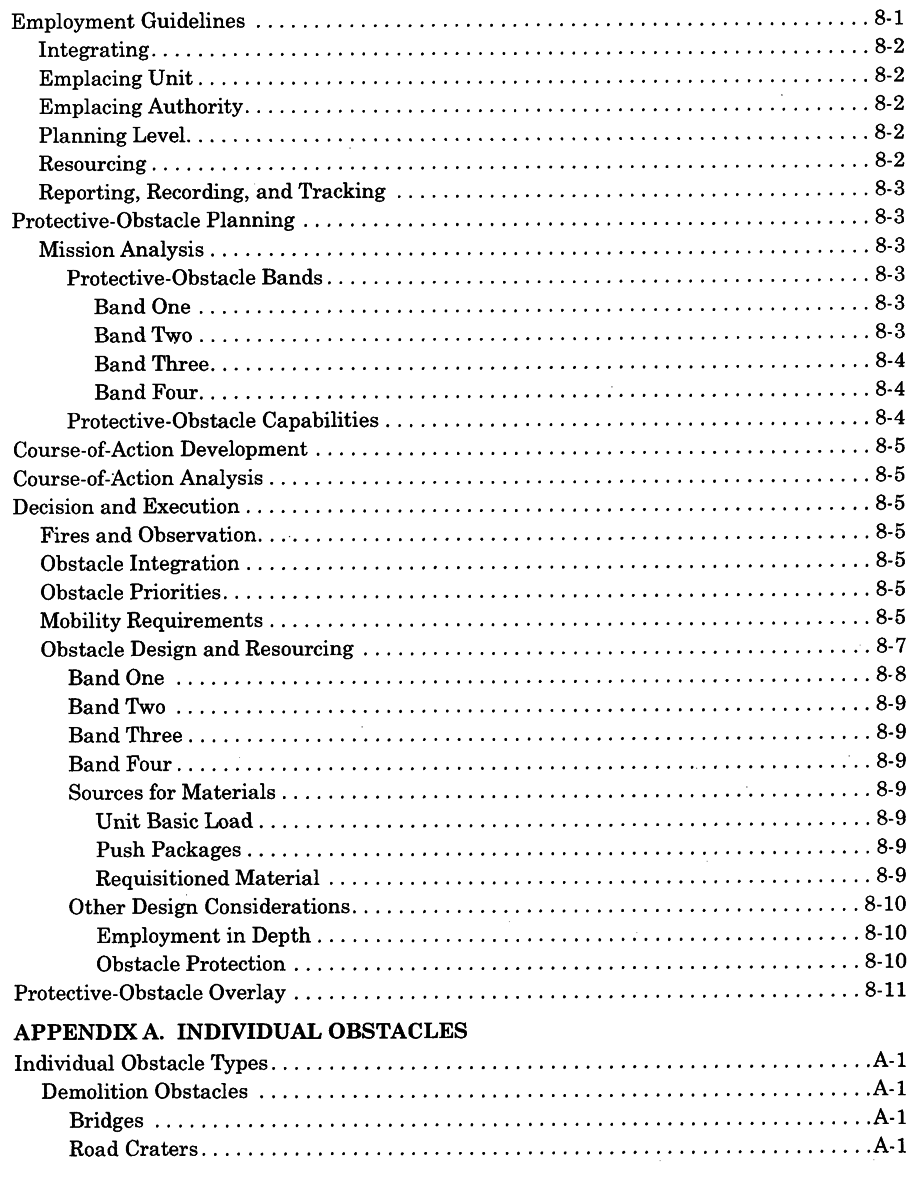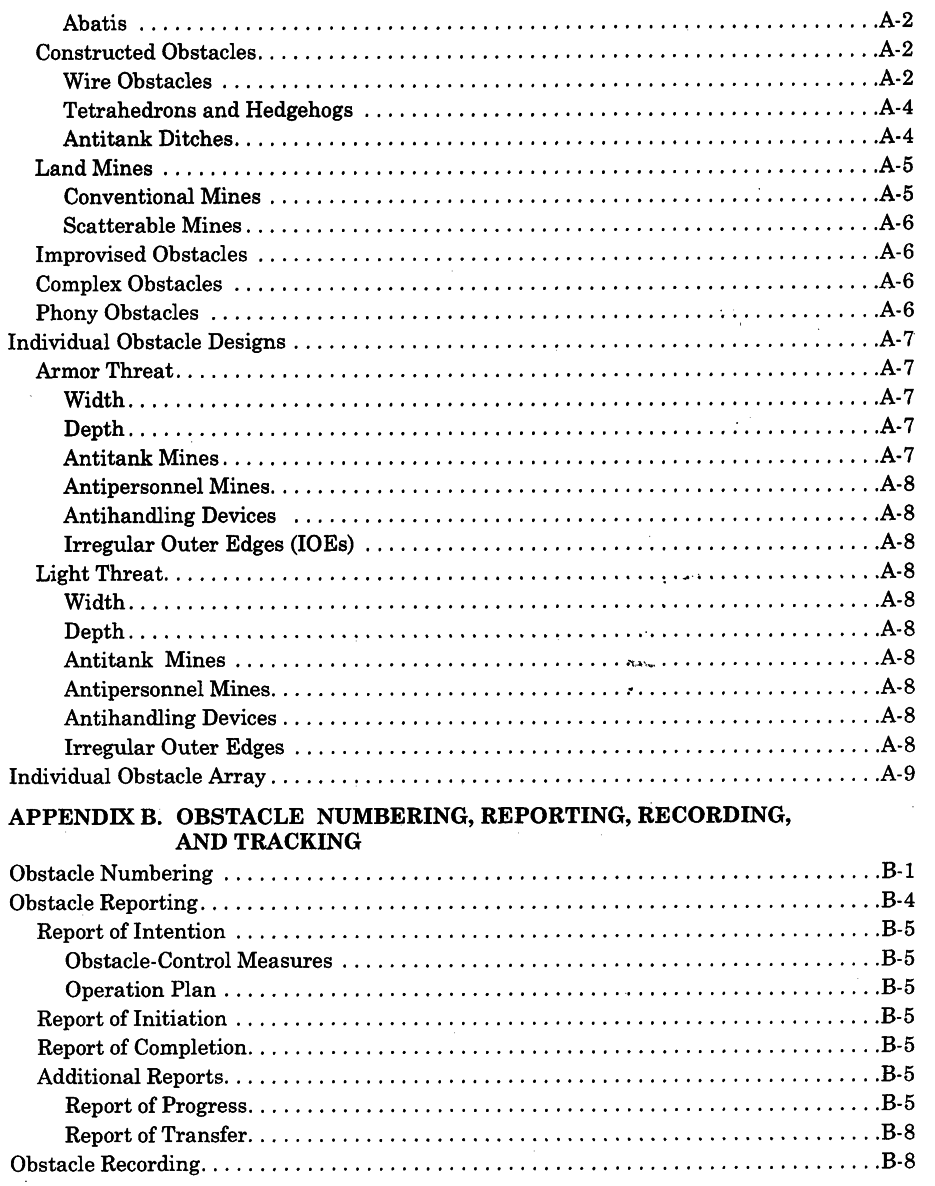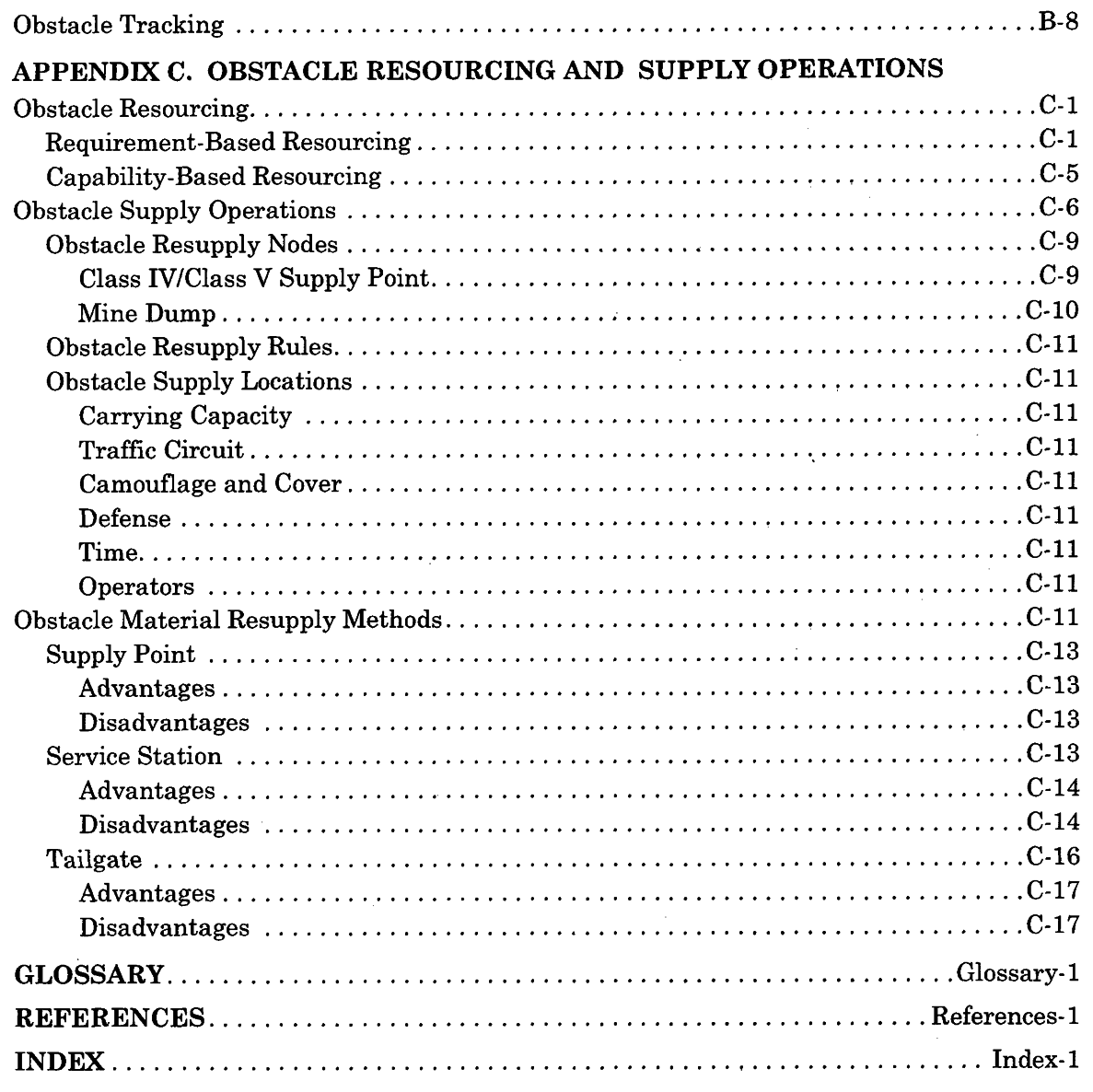FM 90-7
Combined Arms
Obstacle Integration
HEADQUARTERS, DEPARTMENT OF THE ARMY
DISTRIBUTION RESTRICTION: Approved for public release; distribution is
unlimited.

FM 90-7
C1
Change 1
Headquarters
Department of the Army
Washington, DC, 10 April 2003
Combined Arms Obstacle Integration
1. Change FM 90-7, 29 September 1994, as follows: Remove Old Pages
Insert New Pages
B-3 and B-4
B-3 and B-4
2. A bar ( ) marks new or changed material.
3. File this transmittal sheet in front of the publication.
DISTRIBUTION RESTRICTION: Approved for public release; distribution is unlimited.
By Order of the Secretary of the Army:
ERIC K. SHINSEKI
General, United States Army
Chief of Staff
Official:
JOEL B. HUDSON
Administrative Assistant to the
Secretary of the Army
0307104
DISTRIBUTION:
Active Army, Army National Guard, and US Army Reserve: To be distributed in accordance with the initial distribution number 115197, requirements for FM 90-7.












FM 90-7
FM 90-7
FIELD MANUAL
HEADQUARTERS
No. 90-7
DEPARTMENT OF THE ARMY
Washington, DC, 29 September 1994
Combined Arms
Obstacle Integration
Contents
i














FM 90-7
ii














FM 90-7
iii

FM 90-7
iv















FM 90-7
v

FM 90-7
vi

FM 90-7
vii

FM 90-7
viii
FM 90-7
Preface
Field Manual (FM) 90-7 is intended for the combined arms commander and staff. It encompasses doctrine established in FMs 5-100, 6-20 series, 71-100, 100-5, and 100-7. The doctrine presented in the following chapters seeks to develop the full potential of obstacles as a component of combat power. Each chapter contains tactics, techniques, and procedures (TTP) that take the doctrinal foundation and provide the “How To” connection.
This manual initially defines and establishes the principles for obstacle operations then applies them at echelons from corps to company team, concentrating on essential TTPs.
Chapter 2 provides the key obstacle terms that will be used throughout the manual. Chapter 3
covers obstacle integration theory. Chapter 4 covers obstacle planning from corps through brigade level. Chapter 5 covers obstacle planning from task force (TF) through company team level. Chapters 4 and 5 build on the foundations in Chapters 1 through 3 and establish echelon-specific TTPs. Chapters 6 through 8 provide considerations for specific types of obstacles.
Three appendixes provide the additional tools that facilitate successful planning and execution. Appendix A provides information on individual obstacles. Appendix B addresses the critical activities in reporting, recording, and tracking. Finally, Appendix C describes obstacle resourcing and supply.
Throughout this manual, the terms brigade, TF, and company team are used to refer to all friendly brigade-, battalion-, and company-size units (to include cavalry units) unless otherwise noted. The terms regiment, battalion, and company are used only when referring to enemy units unless otherwise noted.
This publication implements international Standardization Agreement (STANAG) 2017.
The proponent for this publication is Headquarters (HQ), United States (US) Army Training and Doctrine Command (TRADOC). Submit comments and recommendations on Department of the Army (DA) Form 2028 and forward it to: Commandant, US Army Engineer School, ATTN: ATSE-T-PD-P, Fort Leonard Wood, MO 65473-6500.
Unless otherwise stated, masculine nouns and pronouns do not refer exclusively to men.
ix
FM 90-7
Chapter 1
Obstacles and the
Combined Arms Team
Obstacles are any characteristics of the ter-
companies. The company was to provide him
rain that impede the mobility of a force.
with a work detail to install the mines and,
Some obstacles, such as mountains, rivers,
more importantly, provide the location of the railway embankments, and urban areas,
minefield.
exist before the onset of military operations.
At 2330 hours, he arrived at the infantry com-Military forces create other obstacles to sup-
pany command post (CP), but no one at the
port their operations. Commanders use
CP could tell him the whereabouts of the work these obstacles to support their scheme of
detail. Nor could anyone tell him where the
maneuver. When integrated with maneuver
minefield should go or what role the mine-
and fires, obstacles can create a decisive bat-
field was to play in the defense. The company tlefield effect. Obstacle plans must mature
executive officer (XO) told the engineer to go as the commanders’ plans mature.
down the road in the direction of the enemy.
He assured the lieutenant that somewhere
HISTORICAL USE OF OBSTACLES
along the road he would meet someone who
undoubtedly was waiting for him.
History shows that obstacles rarely have a
significant effect on the enemy if units do
At 0130 hours, the lieutenant returned to the not integrate them with friendly fires. The
CP after searching along the road and find-
following historical vignette from World War
ing no one. He insisted on speaking with the
II is an example of obstacles that were not
infantry company commander who was sleep-
integrated with fires.
ing. The infantry company commander told
the lieutenant that he would provide him
In February 1942, an engineer lieutenant
with a forty-man detail, led by an infantry
with two noncommissioned officers (NCOs)
lieutenant who would show the engineer
received orders to supervise the installation of where to install the minefield.
a minefield to support the defense of an
American infantry battalion near the Kasse-
At 0330 hours, the infantry lieutenant
rine Pass in Tunisia. The lieutenant set off
showed up with a twelve-man detail. Apolo-
at 1930 hours with a truckload of mines, to
gizing for the small number of men, the
link up with one of the infantry battalion’s
infantry lieutenant also told the engineer
Obstacles and the Combined Arms Team 1-1
FM 90-7
that he had no idea where the mines were to
dismounted infantry forward to breach the
go. The engineer lieutenant moved out with
minefield. When the infantry reached the
the detail to choose a site for the minefield minefield, the Americans would open up
himself. Unfortunately, he had never seen the with machine-gun fire and pound the enemy
site in daylight and was unable to ensure that with artillery and mortar fire. Simulta-the obstacle was covered by fire (it was not).
neously, the American tanks and AT weapons
Additionally, the lieutenant had a small,
would start firing at the North Korean
untrained work crew, without the tools to
armored vehicles.
bury the mines.
In one night engagement, the Americans
When the first Germans arrived at the mine- destroyed eighteen North Korean tanks, four field, they found mines hastily strewn across self-propelled guns, and many trucks and
the road, from a hill on one side to the road personnel carriers, while taking only light
embankment on the other (about 100 meters).
casualties. Although the obstacles alone did
Most mines were not even partially buried.
not defeat the enemy, friendly fires combined German engineers quickly removed the mines
with the effects of the obstacles inflicted
from the road, and the German force contin-
heavy losses on the enemy and halted their
ued forward, unmolested by American fires.
attack.
The minefield was virtually useless.
Despite all of the problems that the lieuten-
ant encountered, his efforts would not have
CHARACTERISTICS OF
been for nothing if the minefield had been
OBSTACLES
integrated with fires. Small arms and artil-
Some obstacles, such as antitank ditches
lery might have wreaked havoc on the dis-
(ADs), wire, road craters (RCs), and many
mounted German engineers, while a single
types of roadblocks, have virtually remained
antitank (AT) weapon might have done the
the same since World War II. They rely on a
same to the German tanks halted behind the
physical object to impede vehicles or dis-
minefield.
mounted soldiers. Normally, they do not
The following historical vignette from the
damage or destroy equipment, nor do they
Korean War illustrates the possibilities
injure or kill soldiers. One exception is a
when a unit integrates fires and obstacles.
booby-trapped obstacle that, when it is
moved, triggers an explosive device; there-
In August of 1950, an American infantry regi-
fore, these obstacles are passive in nature.
ment was defending along a stretch of the
Taegu-Sangju Road known as the “Bowling
Mine warfare, however, has changed signifi-
Alley” in the Republic of Korea. The regiment cantly. Mines, with different fuze types and
had artillery and a few tanks in support.
explosive effects, are different from the
The attacking North Koreans had the advan-
mines of the World War II era (which
tage of superior numbers of armored vehicles.
required physical contact and relied on blast
However, as part of their defense, the Ameri-
effect). Today’s mines are triggered by pres-
cans laid AT minefield close to their infantry sure, seismic, magnetic, or other advanced positions so that they could cover the mine-fuzes. Mines that self-destruct (SD) at
field with small-arms fire. They also prereg-
preset times give commanders influence
istered artillery and mortar fires on the
over how long they remain an obstacle.
minefield.
The invention of programmable mines that
can recognize and attack specific types of
When the North Koreans attacked, they
vehicles within an area brings another
would invariably halt their tanks and send
dimension to the battlefield. Mine warfare
1-2 Obstacles and the Combined Arms Team



FM 90-7
technology continues to outpace counter-
flexible plans, sound organizations, and
mine technology.
logistical support.
Commanders at every echelon consider
Effective obstacle integration enhances the
obstacles and their role in multiplying the
force’s ability to gain, retain, or secure the
effects of combat power to integrate obsta-
positional advantage. The commander and
cles into all combined arms operations.
staff use obstacle integration to develop an
Obstacles that are not properly integrated
obstacle plan as they develop the maneuver
with the scheme of maneuver are a hin-
plan. They use obstacle control to preserve
drance and may be detrimental to the
and protect friendly maneuver and shape
friendly scheme of maneuver by restricting
enemy maneuver. They use obstacles to put
future maneuver options. They will inhibit
the enemy into a positional disadvantage
maneuver until they are breached or
relative to the friendly force.
bypassed and ultimately cleared. The tech-
nology used to create obstacles may continue
to become more complex; however, the basic
FIREPOWER
concepts that affect the integration of obsta-
Firepower provides the destructive force to
cles into the commander’s plan will remain
defeat the enemy’s ability and will to fight.
the same.
It facilitates maneuver by suppressing the
enemy’s fires and disrupting the movement
DYNAMICS OF COMBAT POWER
of his forces.
AND OBSTACLE INTEGRATION
Obstacle integration multiplies the effects
and capabilities of firepower. Obstacle inte-
Commanders combine four primary ele-
gration establishes a direct link between
ments (the dynamics of combat power as
fires, fire-control measures, and obstacle
described in FM 100-5) to create combat
power. They are—
effects. The combination of firepower and
obstacles causes the enemy to conform to the
Maneuver.
friendly scheme of maneuver. Obstacles
Firepower.
magnify the effects of firepower by—
Protection.
Increasing target acquisition time.
Leadership.
Creating target-rich environments.
Obstacles, when properly planned and inte-
Creating vulnerabilities to exploit.
grated into the scheme of maneuver, contrib-
ute to combat power.
PROTECTION
MANEUVER
Protection is the conservation of the fighting
potential of a force so that commanders can
Maneuver is the movement of combat forces
apply it at the decisive time and place. Pro-
to gain positional advantage, usually to
tection has the following components:
deliver—or threaten delivery of—direct and
Maintaining operations security
indirect fires. The effects of maneuver also
(OPSEC) and deception.
may be achieved by allowing the enemy to
move into a disadvantageous position.
Keeping soldiers healthy.
Effective maneuver demands air and ground
Maintaining soldiers’ fighting morale
mobility, knowledge of the enemy and ter-
and safety.
rain, effective command and control (C2),
Avoiding fratricide.
Obstacles and the Combined Arms Team 1-3


FM 90-7
Friendly forces use OPSEC to deny the
obstacle effects and affect both enemy and
enemy information about friendly force
friendly maneuver. The maneuver com-
obstacles to inhibit the enemy’s breaching or
mander uses obstacles integrated with fires
bypassing efforts. They use phony obstacles
and maneuver to create vulnerabilities and
to deceive the enemy about locations of
ensure the enemy’s defeat. Combat service
actual obstacles and friendly positions.
support (CSS) units anticipate and trans-
They use obstacles to prevent enemy entry
port obstacle material to support the obsta-
into friendly positions and installations to
cle effort. Effective C2 provides the unity of
help protect soldiers from enemy assaults.
effort that drives obstacle integration




































































